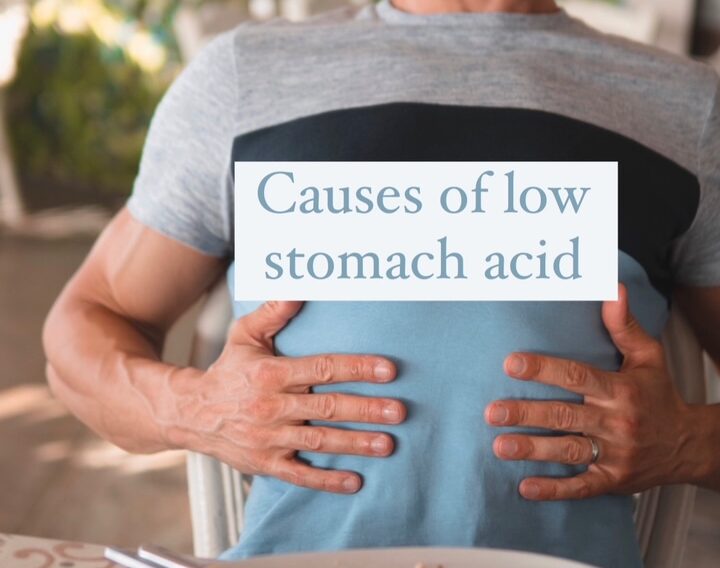One of the most common root causes of digestive systems is low stomach acid. Low stomach acid can lead to bacterial, parasitic and fungal overgrowth in the large and small intestine, which causes IBS-like symptoms.
Bacterial overgrowth in the small intestine (SIBO) is a product of low stomach acid combined with poor motility. But it can also cause bacteria and yeast to overgrow in the large intestine.
Low acid compromises our ability to digest food or kill microbes that we ingest (think food poisoning). Anything we don’t digest is not absorbed and becomes food for gut overgrowths. Low stomach acid can also cause nutritional deficiencies.
Three root causes of low stomach acid
The causes of low stomach acid are:
1) H. Pylori
2) Stress
3) Not enough minerals to build stomach acid
H. pylori’s is a bacterial overgrowth in the stomach that can lower stomach acid significantly. It is very common, often missed and I have written all about it in my H. Pylori Rescue Guide.
Standard h. pylori tests produce a lot of false negatives. The GI Map is the best test for it.
Stress shuts down stomach acid by putting the body into fight or flight mode, putting important functions like digestion and detox on the back burner. It is not important to digest and detox when you are facing a threat.
Unfortunately, people stay in fight or flight indefinitely, which compromises stomach acid production and digestive function.
Lastly, minerals are the building blocks of stomach acid, and without adequate zinc, sodium, potassium and in much lesser amounts, cobalt, the body struggles to produce enough stomach acid.
Low stomach acid and low mineral status can also lead to constipation, anxiety and fatigue. Balancing minerals helps boost stomach acid, which has a downstream effect on other symptoms.
It is important to note, that many people with GERD and reflux actually have low stomach acid instead of high stomach acid. Acid reducing medication may temporary symptom relief but can make gut health worse.
Balancing minerals requires more than just adding in a trace mineral supplements.
Minerals can have an inverse relationship. When you supplement certain minerals, it can lower others.
For example, sodium and potassium have a see saw relationship, if one goes up too high it can bring the other one down too low.
The body need 4700 mg of potassium daily for optimal function and to produce enough stomach acid.
Food sources are coconut water, celery juice, potatoes, tomatoes, dates, avocados and bananas. A banana only has 400 mg of potassium, so you can see how high the body’s needs are versus the food we eat.
Also, supplementing zinc can lower copper in the body and copper is antimicrobial. Inversely, high copper in the body is a common cause of suppressed zinc, which is not only critical for stomach acid but also supports and regulates the immune system.
Minerals and stomach acid
I have always known that minerals play a role in stomach acid but I did not understand how to balance minerals in the body, until now.
I am completing a course on mineral balancing, using a hair sample test to measure mineral status.
The most common cause of mineral depletion is stress and toxicity like heavy metals, and other trapped toxins. The hair mineral test also measures heavy metal status in the body.
If you’re not very stressed and don’t have h. pylori, but still have poor digestion, bloating after meals, burping or food intolerances, stomach acid could be a reason why.
Balancing your minerals can help the body produce more acid and also creates more resiliency against stress.
Knowing your mineral status?
Hair tissue mineral analysis uses hair samples to test for minerals and heavy metals. It tells us if there is enough sodium, potassium and zinc to make adequate acid.
I’m offering the hair tissue mineral analysis (HTMA) test currently at $300 for the test, interpretation and follow up check ins to seamlessly implement the protocol and lifestyle changes suggested.
The HTMA test was the only test I took 20 years ago to bring my gut back into balance and banish 6 years of IBS symptoms till this day.
I suffered from high copper, which brought down my zinc levels. At the time I had from pretty bad reflux and constipation, along with migraines, fatigue and depression.
Balancing my minerals and cleaning up my diet helped me recover.
If you’ve taken a GI Map, you may know that you have low stomach acid. There are several clues on the test (low elastase, high bacteroidetes and or firmicutes, yeast or bacterial overgrowth (particularly staph or strep) and any positives on the first page of the test.
But it doesn’t tell you what the cause of the low acid is unless you also test positive for h. pylori.
Minerals are important building blocks in the body. They are the spark plugs of life, meaning that they catalyze many metabolic reactions and functions in the body, including creating stomach acid and supporting thyroid and adrenal function.
While not an adrenal test, per se, the HTMA can shed light on what is driving the stress as certain mineral patterns correlate with particular stress patterns.
It can also tell if the body has enough energy to heal, by measuring the 4 basic minerals in the body: potassium, sodium, magnesium (the stress mineral) and calcium.
Get in touch if you want to take a deep diver into the root causes of your symptoms. Contact me through the contact form on my site or email angelaprivin@yahoo.com


